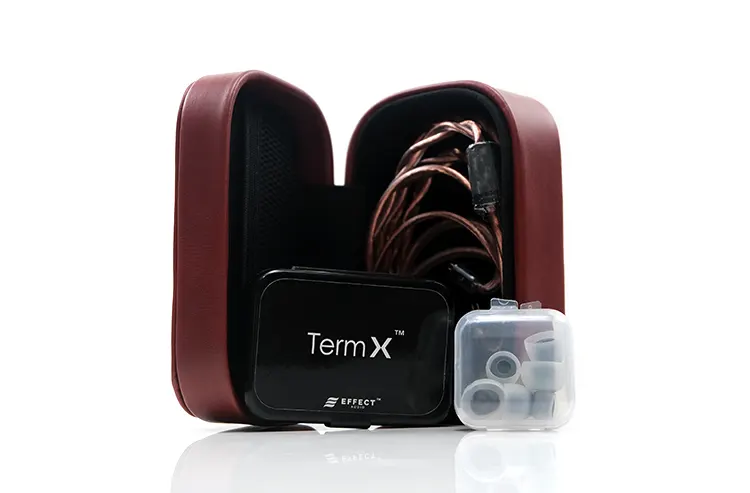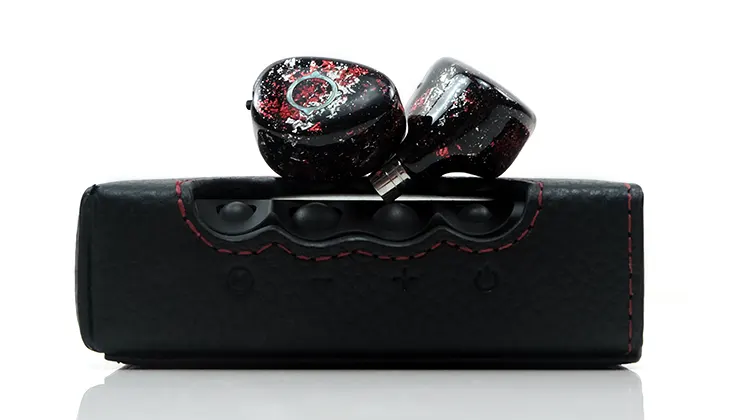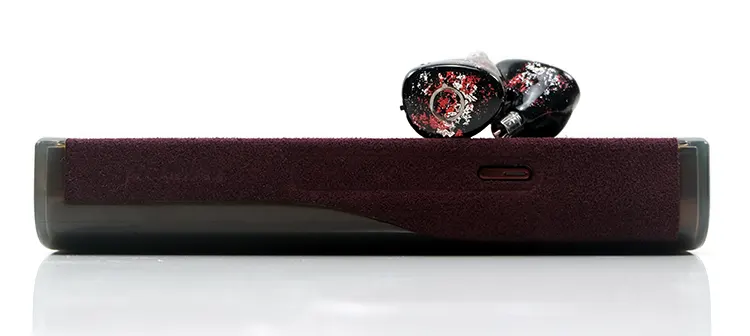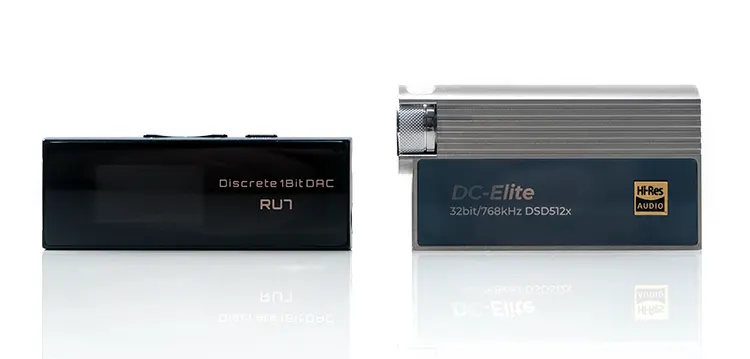Sound Impressions
The following sound impressions of the Lime Ears PNEUMA V2 were completed using a mix of the Chord Electronics Mojo 2 and the ONIX Mystic XP1.
Summary
Hot take, the ANIMA V2 is technically superior to the PNEUMA V2, but the PNEUMA V2’s tonal coloration could make it the more popular choice of these two IEMs.
You get 2 sound signatures for the price of one, a relatively full-sounding yet balanced and spacious default V-shaped tuning with a stronger emphasis on the lows, a mild bump in the mids, and sparkle in the highs.
I hear a warmer, heavier set of lows with a taller bass shelf, enhanced lower-midrange presence, and a hint of additional smoothness in the upper mids with the SubWITCH turned on.
Either option has plenty of the ‘fun factor’ though my choice is to keep the switch off which is the more balanced sounding of the two modes. With the switch in off mode, you get more genre flexibility with the PNEUMA V2.
Upgrade on the Original?
I would also rate it as improved over the PNEUMA V1 though the first edition model still has its charm.
Both PNEUMA models are relatively U or V-shaped, with the PNEUMA V2 doubling down on the emphasis on the extreme ends of the spectrum creating a wider soundstage, rendering the first model comparatively mid-centric with the SubWITCH turned off.
There is an additional dB or two on the very low end of the V2 and beyond 5k it is more consistently elevated up to 10k.
In doing so the newer version has more tonal contrast through the mids, a little more exaggeration on the dip, and a reduced 2-4k bump in the middle. Vocals have plenty of support though with improved 1-2k presence over the original model.
The resulting tuning on the PENUMA V2 sounds cleaner, clearer, and more spacious in its soundstage with better X-Axis detail on layered background notes. The depth and height have also been improved.
The original tended to line up behind the forward-sounding vocal imaging with a slightly softer tonal quality and a narrower soundstage. With the bass switch off the lows on the V1 are more neutral to my ear when both IEMs use the same tips selection.
With the SubWITCH on, there is no question the PNEUMA V2 is the ‘volume’ winner here with a fuller sub-100Hz presence.
The more spacious soundstage from a more pronounced lower-mids dip also creates better breathing space between the lows and mids of the V2. The narrower V1 sounds relatively congested on the same settings.
Frequency Response
The strongest elevation in the PNEUMA V2 in either switch mode is from 20-50Hz, again at 2-3k, and once more around 5-10k where it remains consistent with little in the way of exaggerated peaks and dips in the highs.
The SubWITCH on mode primarily targets the lows and lower mids up to around 800Hz-1k though the widest dB difference of approximately 5-6 dB is from 20Hz to 100Hz, where you will hear the strongest change when you turn it on.
From 100Hz onwards to 1k the dB upswing is gradually reduced to about 1-2 dB in the lower mids. The net effect is more bass volume, more warmth, and more dominance, pushing the midrange presence down a bit as a result.
There also seems to be a slight smoothing of the treble around 4-6k but this is very marginal and could be subjective considering the low’s warmth is more dominant in the mids harmonic balance than with the switch turned off.
A deeper cut around 800hz in the PENUAM V2 lower-mids thins out the mids slightly more than the original PNEUMA. That means vocals are a shade thinner in sustain and body, though not quite as light-bodied as the ANIMA V2.
The fundamental frequency is way more enhanced sounding on the new tuning. Combined with the enhanced presence the coloration has more contrast over the older tuning hence my earlier comment of its sounding somewhat cleaner than the original PNEUMA>
Without the additional bass, the PNEUMA V2 treble presence is more noticeable with some vocal and percussion sibilance. However, the extent of this can vary depending on the source.
For example, the Mojo 2 and the ONIX Mystic XP1 seemed to control it more than the Cayin N7, (which I found slightly surprising).
Staging & Dynamics
The PNEUMA V2 sounds much more spacious than the slightly mid-forward V1 tuning, (switch off mode). The generally more relaxed midrange staging of the V2 is a factor, however, the enhanced bass and treble presence can create a stronger perception of depth and headroom.
What is also very noticeable from the PNEUMA V2 is its improved resolution and dynamic range along the X-Axis.
These same notes on the older tuning tend to shuffle behind the stronger vocal imaging, losing some impact and clarity in the process. Not so on the PNEUMA 2 where notes have a bit more sparkle and clarity creating a much wider and more immersive soundstage in the process.
The power from the enhanced lows is also evident on the PNEUMA V2 with less bleed into the mids compared to the original version. Even with SubWITCH turned on you still get a decent amount of separation.
Tip rolling can further refine the PNEUMA V2 treble presence if you find it too distracting. Switching to SpinFits can smooth out the highs a bit more which is something I use with the ANIMA V2.
Synergy
Efficiency & Sensitivity
Unfortunately, there are no official specifications for the PNEUMA V2. However, we know the ANIMA V2 is rated at 38Ω impedance with an SPL of 104 dB SPL @ 1kHz so we have an indirect benchmark for subjective testing.
Compared to the ANIMA V2, the PNEUMA V2 is much more sensitive, by at least 20 steps using a HiBy R8 II 4.4mm balanced output connection in a low gain turbo mode setting.
For our compared IEMs on page 3 of this review, the PNEUMA V2 is also more sensitive than the Noble Audio Kublai Khan (another one without ratings) but less sensitive than the Campfire Audio Bonneville.
I rate the PNEUMA V2 as fairly easy to drive from a decent source, be it DAP or dongle, and also immune to background hiss from higher noise floors from older portable sources.
DAP Pairings
I tested five portable devices, 3 DAPs, and 2 portable DAC/amps including the HiBy R8 II, Cayin’s N7, ONIX’s Mystic XP1, the Chord Mojo 2, and an older Sony NW-WM1Z.
I started with the Sony to see how its generally lower-powered amp would cope and it did well tonally with a smooth, bottom-weighted tuning and one of the more forgiving treble performances from the PNEUMA V2.
However, could hear the weakness in its Sony low mW amplifier with a reduced level of dynamic range and headroom compared to the modern alternatives.
Especially when compared to the Mystic XP1 which produced a sensational performance with the PNEUMA V2. I felt this was the top dog out of the pairings I tested.
It’s not the most refined for treble smoothness but the weight and depth combined with a vivid vocal imaging experience was very satisfying. It seems the PNEUMA V2 can scale with great power.
Behind that I aimed for the best pairing that could give me the best control and weight on the lows and the smoothest treble or least amount of sibilance.
The Mojo 2 will produce a very neutral treble with less sibilance than I expected but the PNEUMA V2 bass is also relatively neutral compared to the other DAPs. It also delivers a more intimate soundstage that did not mesh as well with SubWITCH turned on.
The N7 opens up the soundstage beautifully, making the PNEUMA V2 bass sound enormous, but it also introduces a little more upper-mid sibilance.
The HiBy R8 II is punchier and more dynamic in its delivery with similar sibilance in vocal performances but a more forward vocal imaging experience than the N7.
Dongle Pairings
I tested four dongles with the PNEUMA V2, and only two of them, the iBasso DC-Elite and the Cayin RU7, could handle the additional bass bloom with any control and definition.
The HiBy FC6 and the Questyle M15 either sounded less defined (FC6) or with too much bloom overpowering a slightly congested and narrower midrange (M15).
The DC-Elite is cleaner and punchier than the RU7, with an emphasis on clarity and headroom. It’s a truly excellent pairing if you want the PENUMA V2 to sound vivid and clear from top to bottom but bear in mind the treble is a bit stronger in this matchup.
The RU7 is smoother to my ear with excellent separation, perhaps more so than the DC-Elite, at least for left-right staging width.
Vocal imaging here is excellent also though surprisingly, I found the DC-Elite to get a slightly better grip on upper-mid sibilance despite it being generally more neutral sounding.
All four dongles had no issue driving the PNEUMA V2. However, out of the four tested, the RU7 and the DC-Elite offered the best dynamic range and resolution.





